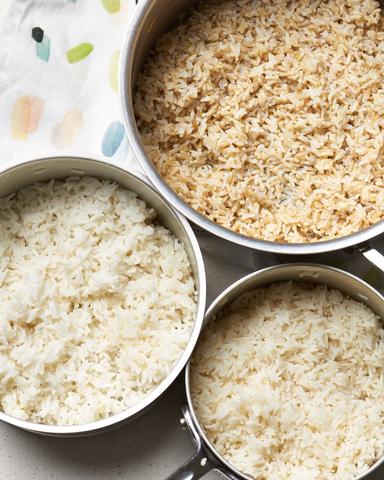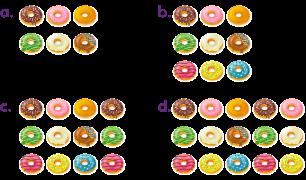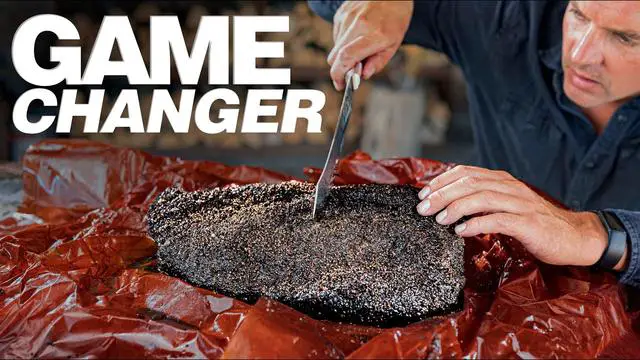
“4 2 10 Brisket: Uncover the Mouthwatering Secrets of the Perfect Barbecue Delight! Discover the art of slow-cooking a succulent brisket with our expert tips and techniques. Elevate your grilling game and impress your guests with tender, flavorful bites that will leave them craving for more. Get ready to savor the ultimate BBQ experience!”
WHAT IS THE 4 2 10 METHOD?

The 4 2 10 method is a cooking technique specifically designed for smoking brisket. It refers to the time intervals when the brisket is cooked, creating a balance between tenderness and flavor. This method involves smoking the brisket for 4 hours at 250°F, followed by an additional 2 hours at 285°F, and finally wrapping it in foil and smoking for 10 hours at a lower temperature of 150°F. This technique allows the meat to absorb the flavors from the smoke, retain its moisture, and achieve the desired level of tenderness.
The popularity of the 4 2 10 method among barbecue enthusiasts stems from its simplicity and consistent results. By following these specified time intervals and using quality ingredients, you can create a perfectly cooked brisket with a smoky bark, moist interior, and optimal tenderness. The key ingredients needed for this method include a well-marbled brisket around 12 to16 pounds, dry rub seasoning of your choice, wood chips for smoking (such as hickory or oak), aluminum foil for wrapping, and a meat thermometer to monitor the internal temperature.
INGREDIENTS NEEDED FOR THE 4 2 10 METHOD
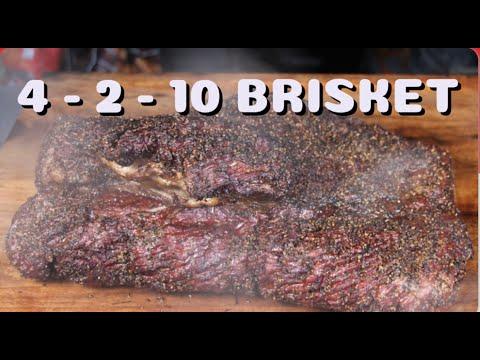
The primary ingredient for the 4 2 10 method is a well-marbled brisket, typically around 12 to 16 pounds, to ensure a juicy and flavorful result. Other essential ingredients include a dry rub seasoning of your choice, wood chips for smoking (such as hickory or oak), aluminum foil for wrapping the brisket, and a reliable meat thermometer to monitor the internal temperature.
For the dry rub, you can choose a seasoning blend that complements your desired flavors. Popular options include a mixture of salt, black pepper, paprika, garlic powder, and other spices. When selecting wood chips, opt for varieties that will enhance the smoky flavor of the brisket. Hickory and oak are commonly used choices, but feel free to experiment with different woods for unique flavors.
Aluminum foil is used during the second phase of cooking to wrap the brisket tightly. This helps retain moisture and tenderize the meat as it cooks. Lastly, having a reliable meat thermometer is crucial for monitoring the internal temperature of the brisket throughout the cooking process to ensure it reaches the desired level of doneness without overcooking.
HOW TO PREPARE THE 4 2 10 BRISKET FOR SMOKING
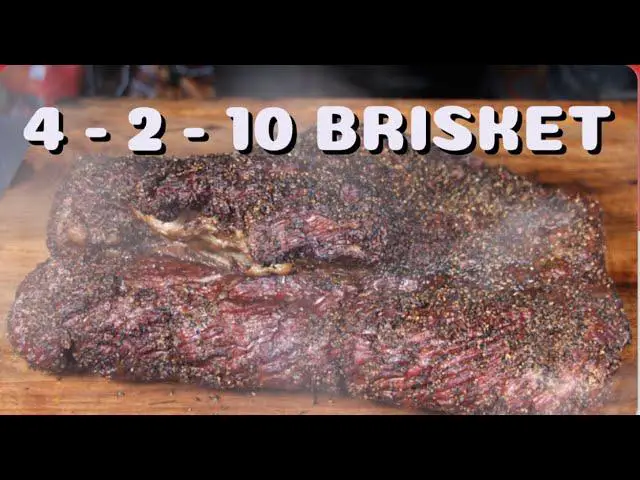
To prepare the brisket for smoking using the 4 2 10 method, there are a few important steps to follow. First, start by trimming any excess fat from the surface of the brisket, leaving a thin layer to enhance flavor and moisture. Next, generously apply your chosen dry rub to all sides of the brisket, ensuring an even coating. This dry rub will add flavor and create a beautiful crust during the smoking process.
Once seasoned, allow the brisket to sit at room temperature for about 30 minutes to allow the flavors to penetrate the meat. While waiting, preheat your smoker to 225°F and fill the water pan. Position the seasoned brisket on the grate and insert a meat thermometer for monitoring.
Proper preparation is crucial for achieving a delicious and tender brisket using the 4 2 10 method. By trimming excess fat, applying a flavorful dry rub, and allowing the meat to rest before smoking, you can ensure that your brisket is ready for its journey towards becoming a mouthwatering masterpiece.
THE 4 2 10 BRISKET SMOKING PROCESS IN 6 STEPS
The 4 2 10 method is a popular and effective technique for smoking brisket, resulting in a tender and flavorful culinary masterpiece. To achieve the perfect brisket using this method, follow these six steps:
Step 1: Preheat the smoker to 250°F (121°C) and soak wood chips for 30 minutes. Make sure there is enough space between the brisket and other items in the smoker for proper air circulation.
Step 2: Place the seasoned brisket fat side up on the smoker grate and insert a meat thermometer to monitor the internal temperature. Ensure that the brisket is centered on the grate for even heat distribution.
Step 3: Smoke the brisket uncovered at 250°F for 4 hours, allowing it to develop a smoky flavor and crust. Periodically baste it with its own juices to enhance flavor and tenderness.
Step 4: Wrap the brisket tightly in foil, increase the smoker temperature to 285°F, and smoke for an additional 2 hours. Monitor the internal temperature to ensure desired tenderness.
Step 5: Reduce the smoker temperature to 150°F and continue smoking the wrapped brisket for another 10 hours. Check wood chips periodically and add more as needed to maintain steady smoke levels.
Step 6: After a total cooking time of approximately16 hours, remove the brisket from the smoker and let it rest briefly before slicing. Remember to slice against the grain for optimal tenderness and texture.
HOW TO SLICE THE BRISKET AGAINST THE GRAIN
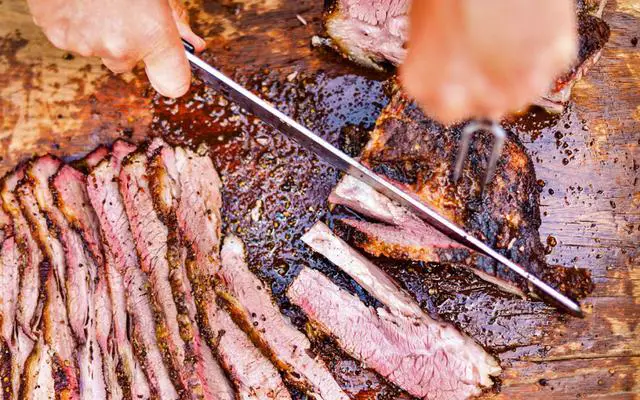
Slicing brisket against the grain is a crucial step to ensure tenderness and optimal texture. Here’s how you can achieve perfectly sliced brisket:
1. Use a meat thermometer to monitor the internal temperature of the brisket. The ideal temperature for slicing is around 195°F (90°C), but you can cook it longer if you prefer a more tender and fall-apart texture.
2. Understand the grain: Before slicing, it’s important to identify the direction of the grain on the brisket. The grain refers to the lines of muscle fibers running through the meat.
3. Locate the grain: Examine the brisket and look for the long, parallel lines that indicate the grain’s direction.
4. Position the brisket: Place the brisket on a cutting board with the fat side facing up.
5. Begin slicing: Using a sharp slicing knife, start by cutting against the grain. Make smooth, even slices about ¼ inch thick.
6. Repeat across the brisket: Continue slicing against the grain, moving across the brisket until all portions have been cut.
FREQUENTLY ASKED QUESTIONS (FAQS):
1. Can I use a gas or electric smoker for the 4 2 10 method?
Yes, you can use a gas or electric smoker for the 4 2 10 method. The key is to maintain a consistent temperature and provide enough smoke for flavor. Both gas and electric smokers can achieve this.
2. Can I add a mop or spritz during the smoking process?
Adding a mop or spritz (a liquid mixture) to the brisket during the cooking process is optional. It can add moisture and enhance flavors, but it’s not necessary for the 4 2 10 method. If you prefer to add a mop or spritz, you can do so during any of the cooking intervals.
HOW DO I KNOW WHEN THE BRISKET IS DONE?
Knowing when the brisket is done can be determined by monitoring its internal temperature. The ideal temperature for slicing is around 195°F (90°C), but you can cook it longer if you prefer a more tender and fall-apart texture. Use a reliable meat thermometer to check the internal temperature at different intervals during the cooking process.
In addition to the temperature, another indicator of doneness is the tenderness of the brisket. You can test this by inserting a probe or fork into the meat. If it goes in with little resistance and comes out easily, then the brisket is likely done. However, keep in mind that each piece of brisket may vary in thickness and marbling, so it’s important to rely on both temperature and tenderness as guides.
CAN I USE A GAS OR ELECTRIC SMOKER FOR THE 4 2 10 METHOD?
Yes, you can use a gas or electric smoker for the 4 2 10 method. The key is to maintain a consistent temperature and provide enough smoke for flavor. Gas smokers typically have a more precise temperature control, making it easier to achieve and maintain the desired cooking temperatures throughout the process. Electric smokers also offer temperature control options and can produce excellent results when used properly. Whichever type of smoker you choose, make sure to follow the recommended time intervals and monitor the internal temperature of the brisket for optimal results.
CAN I ADD A MOP OR SPRITZ DURING THE SMOKING PROCESS?
Adding a mop or spritz during the smoking process is optional and can enhance the flavors and moisture of the brisket. A mop refers to a liquid mixture that is brushed onto the surface of the meat, while a spritz involves spraying a liquid onto the brisket. Both methods help to keep the meat moist and add additional layers of flavor.
If you choose to use a mop or spritz, you can make your own mixture using ingredients such as apple cider vinegar, Worcestershire sauce, or beer. Simply apply the mixture to the brisket every hour or so during the smoking process. This will help to prevent dryness and create a delicious crust on the outside of the meat.
FINAL THOUGHTS
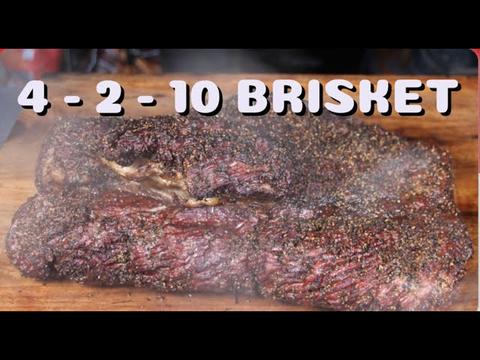
The 4 2 10 method is a tried and true technique for smoking brisket, resulting in a tender and flavorful masterpiece. By following the specified time intervals and using quality ingredients, you can achieve a perfectly cooked brisket with a smoky bark, a moist interior, and optimal tenderness. Whether you choose to use a gas or electric smoker, the key is to maintain a consistent temperature and provide enough smoke for flavor.
While the addition of a mop or spritz during the cooking process is optional, it can add moisture and enhance flavors. However, it’s not necessary for the 4 2 10 method. The simplicity and effectiveness of this cooking technique make it a popular choice among barbecue enthusiasts. So gather your ingredients, prepare your brisket properly, and embark on the delicious journey of creating the perfect 4 2 10 brisket.
In conclusion, the 4-2-10 brisket cooking method is a simple and efficient way to achieve tender and flavorful meat. By seasoning with a rub, slow smoking for 4 hours, wrapping in foil for 2 hours, and finishing on direct heat for 10 minutes, you can enjoy a mouthwatering brisket that will impress your guests.
Learn More About Grilling
If you want to learn more about grilling, check out these other helpful resources!




